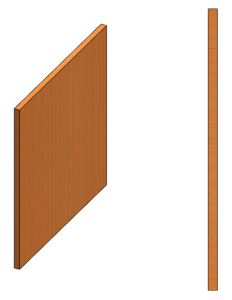Lumped Capacitance Method for Analyzing Transient Conduction Problems: Example Problems
Try to solve these problems before watching the solutions in the screencasts.
Example Problem 1
A hot sphere made of silver is immersed in cool water. The water has a temperature of \(T_∞\) = 290 K. The sphere has an initial temperature of \(T_i\) = 400 K. The convective heat transfer coefficient is \(h\) = 1500 W/m2-K. The sphere has a diameter of \(D\) = 50 mm. Silver has a density of \(ρ\) = 10490 kg/m3, a heat capacity of \(c\) = 230 J/kg-K, and a thermal conductivity of \(k_s\) = 420 W/m-K. How long does it take the sphere to cool to a temperature of 310 K?
Example Problem 2
Consider this plane wall made of wood. It has a thickness of 0.2 m. It is very tall and wide compared to its thickness. It has an initial temperature of \(T_i\) = 20°C. Hot air at a temperature of \(T_∞\) = 325°C convects heat to both sides of the wall with \(h\) = 10 W/m2-°C. The wood has a thermal conductivity of \(k\) = 0.1 W/m-°C, a heat capacity of \(c\) = 2000 J/kg-°C, and a density of \(ρ\) = 500 kg/m3. You are asked to calculate the temperature of the center of the wall after 2 hours (7200 seconds). Determine whether lumped capacitance is an appropriate way to make this calculation.



